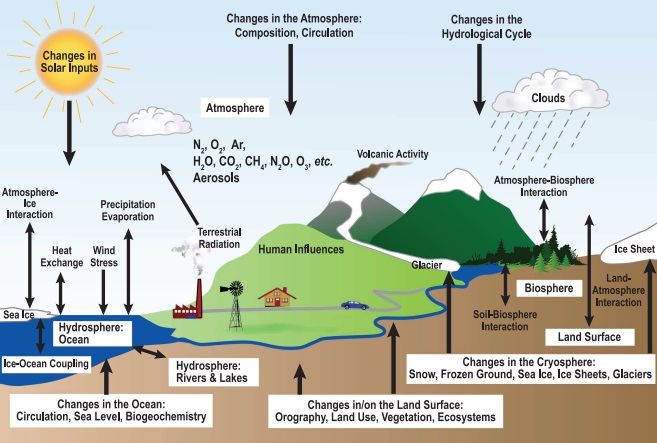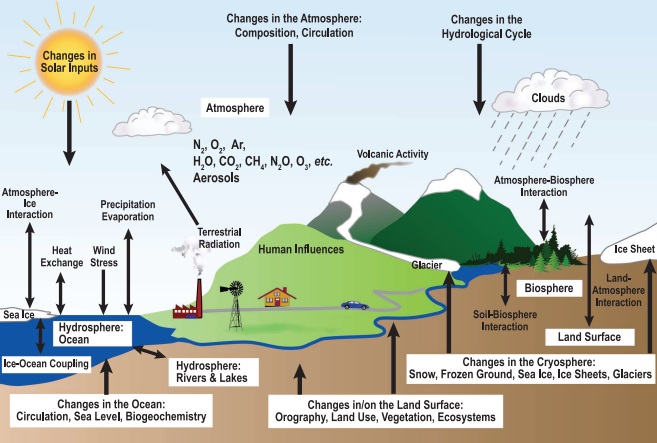Chapter: social science geography student essay
What is the Relationship between Climate Change and Weather?

What is the
Relationship between Climate Change and Weather?
Climate is generally defined as average weather, and as such,
climate change and weather are intertwined. Observations can show that there
have been changes in weather, and it is the statistics of changes in weather
over time that identify climate change. While weather and climate are closely
related, there are important differences. A common confusion between weather
and climate arises when scientists are asked how they can predict climate 50
years from now when they cannot predict the weather a few weeks from now. The
chaotic nature of weather makes it unpredictable beyond a few days. Projecting
changes in climate (i.e., long-term average weather) due to changes in
atmospheric composition or other factors is a very different and much more
manageable issue. As an analogy, while it is impossible to predict the age at
which any particular man will die, we can say with high confidence that the
average age of death for men in industrialised countries is about 75. Another
common confusion of these issues is thinking that a cold winter or a cooling
spot on the globe is evidence against global warming. There are always extremes
of hot and cold, although their frequency and intensity change as climate
changes. But when weather is averaged over space and time, the fact that the
globe is warming emerges clearly from the data.
Meteorologists put a great deal of effort into observing,
understanding and predicting the day-to-day evolution of weather systems. Using
physics-based concepts that govern how the atmosphere moves, warms, cools,
rains, snows, and evaporates water, meteorologists are typically able to
predict the weather successfully several days into the future. A major limiting
factor to the predictability of weather beyond several days is a fundamental
dynamical property of the atmosphere. In the 1960s, meteorologist Edward Lorenz
discovered that very slight differences in initial conditions can produce very
different forecast results. This is the so-called butterfly effect: a butterfly
flapping its wings (or some other small phenomenon) in one place can, in
principle, alter the subsequent weather pattern in a distant place. At the core
of this effect is chaos theory, which deals with how small changes in certain
variables can cause apparent randomness in complex systems.

Nevertheless, chaos theory does not imply a total lack of
order. For example, slightly different conditions early in its history might alter
the day a storm system would arrive or the exact path it would take, but the
average temperature and precipitation (that is, climate) would still be about
the same for that region and that period of time. Because a significant problem
facing weather forecasting is knowing all the conditions at the start of the
forecast period, it can be useful to think of climate as dealing with the
background conditions for weather. More precisely, climate can be viewed as
concerning the status of the entire Earth system, including the atmosphere,
land, oceans, snow, ice and living things (see Figure 1) that serve as the
global background conditions that determine weather patterns. An example of
this would be an El Ni-o affecting the weather in coastal Peru. The El Ni-o
sets limits on the probable evolution of weather patterns that random effects
can produce. A La Ni-a would set different limits.
Another example is found in the familiar contrast between
summer and winter. The march of the seasons is due to changes in the
geographical patterns of energy absorbed and radiated away by the Earth system.
Likewise, projections of future climate are shaped by fundamental changes in
heat energy in the Earth system, in particular the increasing intensity of the
greenhouse effect that traps heat near Earth's surface, determined by the
amount of carbon dioxide and other greenhouse gases in the atmosphere.
Projecting changes in climate due to changes in greenhouse gases 50 years from
now is a very different and much more easily solved problem than forecasting
weather patterns just weeks from now. To put it another way, long-term
variations brought about by changes in the composition of the atmosphere are
much more predictable than individual weather events. As an example, while we cannot
predict the outcome of a single coin toss or roll of the dice, we can predict
the statistical behaviour of a large number of such trials.
While many factors continue to influence climate, scientists
have determined that human activities have become a dominant force, and are
responsible for most of the warming observed over the past 50 years.
Human-caused climate change has resulted primarily from changes in the amounts
of greenhouse gases in the atmosphere, but also from changes in small particles
(aerosols), as well as from changes in land use, for example. As climate
changes, the probabilities of certain types of weather events are affected. For
example, as Earth's average temperature has increased, some weather phenomena
have become more frequent and intense (e.g., heat waves and heavy downpours),
while others have become less frequent and intense (e.g., extreme cold events).
Related Topics